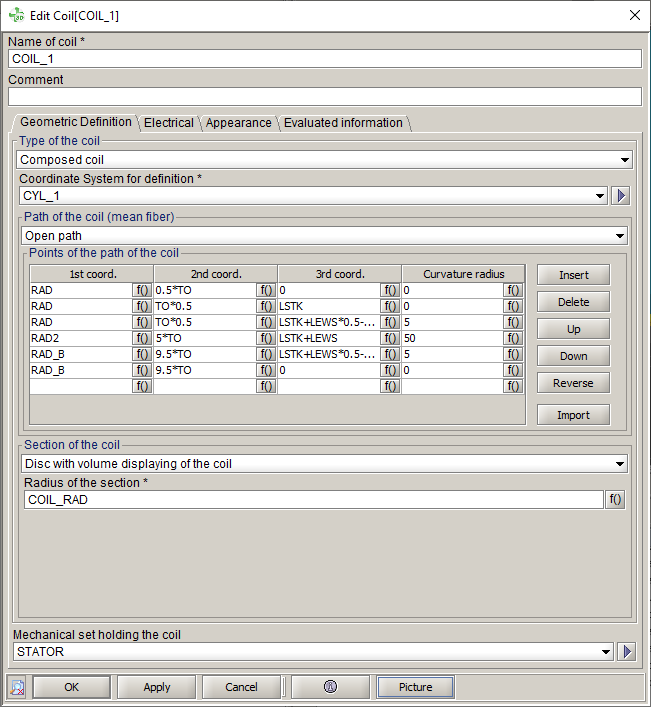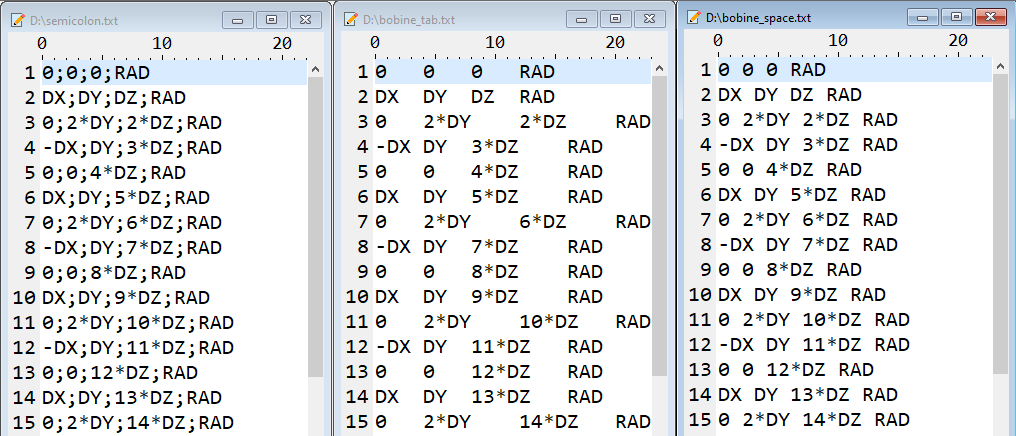Composed coil
Shape and dimension
Composed coils are ones which complex shape is defined by the user.
The shape of the coil is the path (open or closed) composed by a set of points. The connecting elements between the points are built on the basis of straight segments with taking into account of the curves if they exist, as presented on the figure below. A curvature radius, associated to the point, defines the curve.
|
Composed coil with closed path, described by 3 points |
Composed coil with open path, described by 3 points |
|---|---|
|
|
|
| a curvature radius R = 0 |
a curvature radius R is associated to the point P 2 |
Current direction
A coil is defined in a proper coordinate system. The direction of the current is dependent on the orientation of this coordinate system and the arrow on the image of the coil defines the direction of the positive current in the coil.
In the composed coil the direction of the current follows the succession of the points.
The user can easily change the current direction by reversing the order of the points
via the button  .
.
Sections
The types of associated sections are presented in the table below.
| Section | Composed coil |
|---|---|
|
Line *
|
|
|
Disc (volume displaying)
|
|
|
Disc (the mean fiber displaying)
|
 |
|
Rectangle
|
|
Orientation of a rectangular section
For rectangular sections (sections of line or rectangle type), it is necessary to define the position of section as presented in the figure below.
The orientation of section is defined in the plane perpendicular to mean fiber
There are two different situations:
-
if a coil is formed of several not aligned segments :
the orientation is predefined and fixed by Flux
-
if a coil is formed of only one segment (or several aligned segments ):
the orientation is free and defined by the user
These two situations are detailed in following blocks.
Orientation (1)
The orientation for a coil formed of several not aligned segments is imposed by Flux. The orientation of a section is a function of the coil shape, i.e. of its segments positioning.
The user can define a rotation angle of 90° to make turn the rectangular section of 90°; but that is equivalent to swap the height and width values.
In the example below the section of rectangle type is oriented using the rotation angle.
| Rotation angle = 0° | Rotation angle = 90° |
|---|---|
Orientation (2)
The orientation for a coil formed of only one segment (or of some aligned segments ) is defined using an orientation vector and a rotation angle (optional) as represented in the table below.
- an orientation vector
 gives the direction of the width / thickness
of the section for an angle of 0° in the plane of the section (see figure
below)
gives the direction of the width / thickness
of the section for an angle of 0° in the plane of the section (see figure
below)
- a rotation angle α (optional) is the angle of the clockwise section rotation
in the plane of the section (see figure below)
Example of orientation
In the example below the section is oriented using:
- the
 vector to define the width (or the thickness)
position
vector to define the width (or the thickness)
position - the rotation angle equal to 0°
If the vector ![]() is not in the plane of the section, Flux projects it in
this plane.
is not in the plane of the section, Flux projects it in
this plane.
The vector ![]() should not be collinear with the segments.
should not be collinear with the segments.
Help for creation
To facilitate the creation of composed coils (non meshed), several features are available in the creation dialog box :

- Insert a point in the list via the button
 .
. - Delete a point in the list via the button
 (after activating one of the cells of the
line to be deleted).
(after activating one of the cells of the
line to be deleted).The definition line of the point is fully deleted, i.e. the 3 coordinates as well as the curvature radius.
- Move a point up or down using the
buttons
 and
and  (after activating one of the cells of the line to be
deleted).
(after activating one of the cells of the line to be
deleted). - Reverse the order of the points in the table using the button
 (allows, among other things, to easily change the
direction of the current in the coil).
(allows, among other things, to easily change the
direction of the current in the coil). - Import a list of points contained in a TXT
file in order to fill the points table with the desired list of points
via the button
 .
.If the table already contains points, the import will overwrite them all and replace them with the list of points of the imported file.
The file must contain 4 columns: the coordinates X, Y, Z and the value of the curvature radius. The separator can be:
- a semicolon
- a space
- a tabulation
